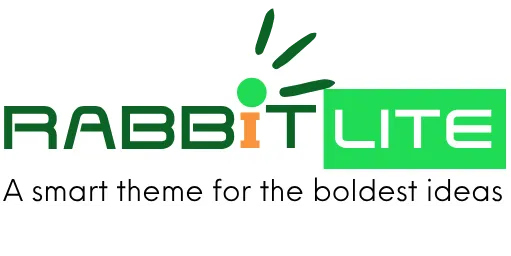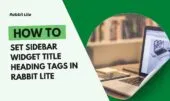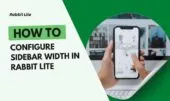- 1. Standard Logo Sizes for Websites
- 2. What is the Best Logo Size for Website?
- 3. Why Setting the Best Logo Size Matters
- 4. How to Set Best Logo Size in Rabbit Lite
- 5. Recommended Logo Widths for Desktop and Mobile
- 6. Types of Logos and Applications
- 7. Troubleshooting Logo Display Issues
- 8. Best Practices for Logo Implementation
- 9. Impact on Branding and UX
- 10. FAQ
- 10.1. What happens if my logo is too large?
- 10.2. Can I set different logo widths for desktop and mobile?
- 10.3. How do I test the logo display on various devices?
- 10.4. What is the ideal logo size for website headers?
- 10.5. How do I ensure my logo is optimized for WordPress?
- 11. Conclusion
Setting the best logo size for website is essential for creating a professional and visually appealing layout that attracts visitors, reinforces branding, and ensures consistent presentation across devices. With Rabbit Lite, you can customize the Max Logo Width separately for desktop and mobile, allowing a fully responsive logo that enhances user experience and maintains design harmony.
Improper logo sizing can disrupt your website layout and affect brand appearance, potentially causing confusion or a poor first impression. Using Rabbit Lite logo settings allows you to optimize display, ensuring your logo remains clear, balanced, and visually harmonious on all devices.
Adjusting desktop logo width and mobile logo width helps your website maintain layout structure, improve design aesthetics, and provide an optimal user experience. This guide provides step-by-step instructions and best practices for setting the best logo size for website using Rabbit Lite, including recommended dimensions, pixel sizes for WordPress, and tips on aspect ratio and resolution.
Standard Logo Sizes for Websites
Choosing the right standard logo size ensures clarity, professionalism, and consistent display across different platforms and screen resolutions.
- Common Sizes: Logos typically range from 250×100 to 400×100 pixels, offering flexibility while maintaining balance in header design.
- Horizontal Design: For horizontal layouts, 250×150 pixels is recommended to ensure proper alignment and visibility across all devices.
- Vertical Design: Vertical logos are usually 160×160 pixels, suitable for areas with limited horizontal space while remaining clear and legible.
- File Format: PNG format is recommended for high quality and transparent backgrounds, while JPG can be used but lacks transparency support.
- File Size: Keep the logo file size under 200KB to guarantee fast page loading and prevent slow website performance.
- Pixel Units: Always use pixels (px) for measurements to maintain consistency and accuracy in logo display across devices.
- Aspect Ratio: Maintaining common aspect ratios such as 3:2, 4:3, or 1:1 ensures your logo displays beautifully on all devices without stretching or distortion.
What is the Best Logo Size for Website?
Understanding the best logo size for website ensures your branding displays professionally and consistently across devices, preserving a clean and user-friendly interface.
- Max Logo Width sets the maximum space your logo can occupy, preventing layout breaks and misalignment in headers or menus.
- Separate settings for desktop and mobile allow the logo to adjust responsively and maintain visual balance on all screen sizes.
- Using optimal pixel dimensions improves clarity, brand recognition, and overall aesthetic impact across your website.
- Configuring Rabbit Lite logo settings guarantees headers and branding elements remain aligned, consistent, and visually harmonious.
- Whether designing for WordPress or custom websites, the correct pixel size ensures the logo appears crisp and professional on all devices.
Why Setting the Best Logo Size Matters
Proper logo sizing is crucial to prevent layout disruption and maintain a consistent, professional user experience across desktop and mobile devices.
- Oversized logos can push menus, overlap content, or break header alignment, reducing usability and impacting visual aesthetics.
- Setting desktop logo width and mobile logo width guarantees consistent branding across all devices, avoiding uneven or distorted displays.
- A responsive logo retains clarity, readability, and proper alignment on every screen size, from desktop monitors to mobile phones.
- Optimized logo sizing contributes to better website layout balance and a more polished, professional user experience.
- Using ideal logo sizes for website headers ensures a visually appealing and coherent design across different platforms.
How to Set Best Logo Size in Rabbit Lite
Adjusting the Max Logo Width in Rabbit Lite is straightforward, allowing your logo to remain responsive, visually balanced, and professionally presented.
- Navigate to Rabbit Lite > Settings > Main Settings to access the logo configuration panel and make adjustments easily.
- Enter desktop logo width and mobile logo width in the Best Logo Size fields to set maximum display dimensions.
- Use pixels (px) for all measurements to maintain consistent and precise sizing across all devices.
- Click Save Settings and preview the website on multiple devices to ensure the logo displays properly and scales as intended.
- Adjust as necessary to achieve a balanced header, responsive layout, and optimal visual presentation.
- Test Across Devices: Always check how the logo looks on desktops, tablets, and mobile phones to ensure it appears correctly and maintains visual balance.
Recommended Logo Widths for Desktop and Mobile
Selecting the right width for desktop and mobile improves logo display optimization and maintains professional aesthetics across your website.
- Desktop logos typically range from 150px to 300px, fitting headers without breaking the layout or appearing disproportionately large.
- Mobile logos are smaller, usually between 100px and 200px, ensuring clarity and readability on narrow screens while maintaining design consistency.
- For WordPress websites, aim for best logo size for WordPress website within these ranges to achieve the best balance and alignment.
- Test different sizes to find the perfect balance between visibility, clarity, and overall layout integrity on all devices.
- Combined with a responsive logo design, these settings ensure the logo displays optimally on desktops, tablets, and mobile devices.
Types of Logos and Applications
Different types of logos are suitable for various purposes and display requirements across platforms and screen sizes.
- Horizontal Logo: Commonly used for website headers, with popular sizes including 250×100, 350×75, and 400×100 pixels, fitting wide layouts.
- Square Logo: Ideal for favicons, social media avatars, and mobile applications, with typical sizes of 16×16, 32×32, and 48×48 pixels.
- Vertical Logo: Suitable for special designs or where horizontal space is limited, commonly 160×160 pixels to maintain clarity and proportion.
Troubleshooting Logo Display Issues
Correct logo sizing ensures your website maintains a professional appearance without layout breaks or distorted elements.
- Oversized logos may overlap menus or header elements, creating a confusing and poor user experience.
- Logos exported at incorrect pixel dimensions can appear blurry or pixelated, reducing professionalism.
- Adjust Max Logo Width in Rabbit Lite logo settings to fix scaling and display problems across devices.
- Preview the website on multiple devices to confirm the logo scales correctly, maintaining balanced layout and proper alignment.
- Consider creating multiple pixel-size versions to ensure optimal display across different devices and screen resolutions.
Best Practices for Logo Implementation
Following best practices ensures your logo displays clearly, consistently, and professionally across all devices and platforms.
- File Format: Use PNG format for high quality and transparent backgrounds, ensuring the logo looks clean on any page background.
- File Size: Keep the logo file under 200KB to prevent slow page loading and maintain optimal website performance.
- Multiple Sizes: Create various pixel-size versions to accommodate different devices, screens, and application needs.
- Test on Devices: Verify the logo display on desktops, tablets, and mobile devices to ensure consistent appearance and readability everywhere.
- Resolution Note: Use 72 DPI for web display to maintain clarity and 300 DPI if the logo is also intended for print, ensuring high-quality output.
Impact on Branding and UX
Proper logo sizing improves branding and user experience, ensuring your website looks professional, polished, and visually appealing.
- A correctly sized logo is easily recognizable, reinforcing brand identity and leaving a strong impression on visitors.
- Maintaining website layout balance ensures headers, menus, and logos display harmoniously across all screen sizes.
- Clear and responsive logos support intuitive navigation, consistent design, and a professional presentation on all devices.
- Proper logo sizing prevents layout breaks, keeping headers clean, organized, and visually appealing.
- Optimal pixel dimensions strengthen brand perception and leave a lasting impression on users across WordPress or custom websites.
FAQ
Frequently asked questions about setting the best logo size for website using Rabbit Lite, helping optimize branding and layout across devices while maintaining a polished appearance.
What happens if my logo is too large?
If your logo exceeds the maximum pixel width, it may break the header layout or overlap menus, reducing usability. Adjusting Max Logo Width ensures a responsive logo and maintains layout balance for all devices.
Can I set different logo widths for desktop and mobile?
Yes, Rabbit Lite allows configuring desktop logo width and mobile logo width separately in pixels, keeping the logo clear, balanced, and fully responsive across different screen sizes.
How do I test the logo display on various devices?
Preview your website on desktop, tablet, and mobile after setting the Best Logo Size in pixels. Ensure the responsive logo displays correctly, maintains layout integrity, and adjusts appropriately for all screen widths.
What is the ideal logo size for website headers?
The ideal logo size for website headers typically ranges from 150px–300px for desktop and 100px–200px for mobile, depending on your theme and layout, ensuring visibility without breaking the design or layout structure.
How do I ensure my logo is optimized for WordPress?
Follow platform-specific guidelines: for WordPress, stick to recommended pixel sizes and header alignment. Using Rabbit Lite settings with max logo width in pixels ensures proper responsiveness and consistent appearance.
Conclusion
Setting the best logo size for website using Rabbit Lite ensures your branding remains clear, professional, and visually appealing on both desktop and mobile, improving overall layout balance and user experience.
By following recommended pixel dimensions and using Rabbit Lite logo settings, you can maintain a visually harmonious design, prevent layout breaks, and optimize logo display for all visitors on your Rabbit Lite-powered website.









